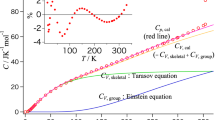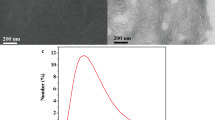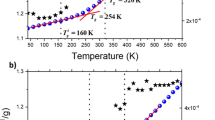Abstract
THERE has been increasing interest in the investigation of thermal transitions in cellulose. It has been established that the glass transition temperature is in the region 200°–250° C, and there is ample experimental evidence to indicate a transition at 20°–25° C. This transition is also seen in glucose and cellobiose1–3. The purpose of this communication is to report a recently discovered transition at around −30° C, observed in measurements of damping and thermal expansion of paper produced from wood cellulose.
This is a preview of subscription content, access via your institution
Access options
Subscribe to this journal
Receive 51 print issues and online access
$199.00 per year
only $3.90 per issue
Buy this article
- Purchase on Springer Link
- Instant access to full article PDF
Prices may be subject to local taxes which are calculated during checkout
Similar content being viewed by others
References
Goring, D. A. I., Proc. Symp. Consolidation of the Paper Web, Cambridge, 1965, 555 (BP and BMA, London, 1966).
Wahba, M., J. Text. Inst., 56, T 218 (1965).
Ramiah, M. V., and Goring, D. A. I., J. Pol. Sci., C, No. 11, 27 (1965).
Kubát, J., and Lindbergson, B., Svensk Papperstidn., 68, 743 (1965).
Zanetti, R., J. Pol. Sci., 62, 33 (1962).
Author information
Authors and Affiliations
Rights and permissions
About this article
Cite this article
KUBÁT, J., PATTYRANIE, C. Transition in Cellulose in the Vicinity of −30° C. Nature 215, 390–391 (1967). https://doi.org/10.1038/215390a0
Received:
Issue Date:
DOI: https://doi.org/10.1038/215390a0
This article is cited by
-
Fabrication and characterization of transparent and biodegradable cellulose/poly (vinyl alcohol) blend films using an ionic liquid
Cellulose (2013)
-
Blend films of natural wool and cellulose prepared from an ionic liquid
Cellulose (2010)
-
The glass transition and crystallization of ball milled cellulose
Cellulose (2010)
-
Einfluß thermischer Behandlung auf Cellulose
Holz als Roh- und Werkstoff (1971)
Comments
By submitting a comment you agree to abide by our Terms and Community Guidelines. If you find something abusive or that does not comply with our terms or guidelines please flag it as inappropriate.



